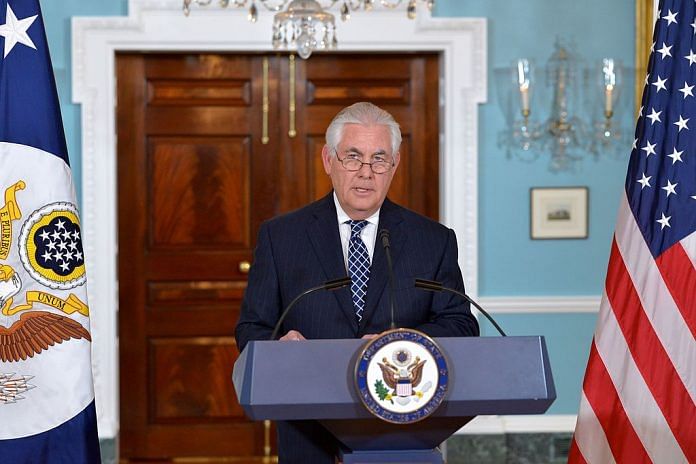Ahead of his visit to New Delhi, US Secretary of State reveals the Indo-US relationship will also be firm on terrorism, and open for business.
Underpinned by a significant policy shift in Washington’s South Asia strategy, US Secretary of State Rex Tillerson, who will be in New Delhi next week, outlined the Trump administration’s India vision Wednesday.
The script sounded good. Tough on China, firm on terrorism, and open for business, Tillerson talked up India as a key lynchpin in the US strategy for the Indo-Pacific, even going to the extent of saying that Washington will look to “complement” India’s Act East policy.
But what does this mean in substantive terms, on the ground? Tillerson provided considerable clarity in his remarks, points that need to be fleshed out for the bigger picture to emerge.
Alternate plan to counter OBOR
It’s clear from what Tillerson articulated that both India and US are working on an alternate “financing arrangement” for smaller countries to build their infrastructure.
Finances through this model will never be as cheap as China is offering through One Belt One Road, but India and US will combine their diplomatic energies to get these smaller countries to look at the long-term implications, of taking into account the possibility of bartering sovereignty and control to the Chinese, and then getting into a deadly debt trap.
This would be a significant diplomatic effort, which will also look to counter existing China-financed infrastructure projects in South and East Asia.
‘Asia-Pacific’ is now ‘Indo-Pacific’
The US has officially embraced this strategic frame which was first articulated by Japanese Prime Minister Shinzo Abe the last time he was his office. The idea was welcomed but there was worry in the US, even India, on whether this may appear an alliance among prominent democracies against China.
The way in which the idea of a quadrilateral dialogue between India, US, Japan, and Australia fell apart some years ago after China issued official demarches to all four countries was a big setback to Abe’s vision. He, however, continued to refer to the expanse as Indo-Pacific.
Tillerson only used this formulation and not just that, he made it clear that US will make every effort to bring Australia, which has fought every war alongside the US, on board the Indo-Pacific platform.
The big picture then becomes clear – India, US, Japan, and Australia combining to protect a “rules-based order” in the Indo-Pacific. As Tillerson drew the line himself: “We need to collaborate… so that it (Indo-Pacific) does not become a region of disorder, conflict, and predatory economics.”
Global designation of terrorists will be a joint enterprise
This is a big step in the direction of countering the Chinese hold in the United Nations on designating Lashkar-e-Taiba and Jaish-e-Muhammed terrorists in Pakistan. This was agreed when Prime Minister Narendra Modi travelled to the US, and the first meeting is slated for December.
The principal argument that China has always brought forward against Indian efforts in the US is ‘lack of proper evidence’ against these terrorists. Through this mechanism, India and US will combine efforts to collect much more evidence against Pakistan-based terrorists and terrorist outfits inimical to Indian interests.
The US administration’s deep access within Pakistan is expected to bring more current and credible information to the table. Not just that, it may help identify more individual and entities. The plan, insiders told ThePrint, is to jointly push cases for designation.
Separately, India is looking at overhauling its own terror designation system, which can also gain from the US system of terror designation.
Underpinning this cooperation on terror, Tillerson used a narrative that India has often showcased: “India’s diverse population includes more than 170 million Muslims, the third largest Muslim population in the world. Yet, we do not encounter a significant number of Indian Muslims among fighters of the ISIS or other terrorist groups, which speaks to the strength of Indian society.”
Build up Indian defence
This is now a strategic objective for the US under President Donald Trump. Washington is willing to share technologies, explore ‘Make in India’ options and provide high-end equipment in a way that’s not been done before. It still needs to be tested in reality, given tough American end-user requirements.
But what’s clear is that the US is keen for India to emerge as a maritime power in the Indo-Pacific. For this, Tillerson and US Secretary of Defence James Mattis, who visited earlier, are on the same page.
Free trade and prosperity versus China’s predatory economics
For all the concerns in Europe over American protectionism under Trump, the vision for India clearly articulates a partnership to promote a rules-based order and free trade.
This is an important message of assurance to India and a signal to East Asia because in the case of Europe, China stepped in very quickly to state that it will uphold the principle of free trade if the US were to withdraw into a protectionist mode.
Clearly, the US has learnt its lesson and is not ceding any space in this part of the world.







A brilliant analysis of Indo-Pacific strategic alliance of sort. We need to debate this issue further keeping our national interest in view. India cannot diverse its interest from the Himalayan kingdoms which are being eyed by China for furthering their economic and strategic interest. Our resources are limited for the present to dominate the blue seas of Indo-Pacific region as equal partners with US-Japan and Australia. Geopolitical significance of our island territories need to be exploited. I feel this issue needs to be further debated within our country’s intelligentsia. Pranab has given us a lot food for thought!